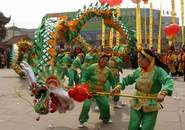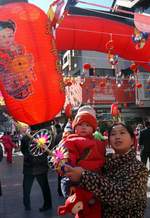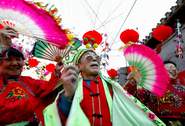 |
| Lantern Festival |
 Yuanxiao Festival or the Lantern Festival is a traditional Chinese holiday on the 15th day of the 1st lunar month, fourteen days after Chinese New Year's Day. In the country and town, people celebrate it heartily. For some reason, there is often a bigger celebration in the rural areas, especially in the North. Yuanxiao Festival or the Lantern Festival is a traditional Chinese holiday on the 15th day of the 1st lunar month, fourteen days after Chinese New Year's Day. In the country and town, people celebrate it heartily. For some reason, there is often a bigger celebration in the rural areas, especially in the North.
The most popular food for this festival is Yuanxiao, a kind of sweet dumpling made of glutinous rice or wheat flour. Apart from Yuanxiao, the customary foods vary from place to place. In Shaanxi Province, people take Yuanxiao tea, a sort of soup made of boiled flour mixed with vegetables and fruits; in Luoyang and Lingbao Cities, Henan Province, people favor jujube paste; in Kunming City, Yunnan Province, people prefer bean dough.
 Other folk customs of the Lantern Festival include attending the lantern fair, guessing riddles and performing traditional festivities. The following is a scene at a Yuanxiao celebration in Xue Village, Hancheng, Shaanxi Province. Around 10 am, the villagers from all corners of the village, "armed to teeth," come to gather in the village square for the festivities. In no time, the villagers seethe with excitement. Other folk customs of the Lantern Festival include attending the lantern fair, guessing riddles and performing traditional festivities. The following is a scene at a Yuanxiao celebration in Xue Village, Hancheng, Shaanxi Province. Around 10 am, the villagers from all corners of the village, "armed to teeth," come to gather in the village square for the festivities. In no time, the villagers seethe with excitement.
There are mixed sounds made by gongs and drums, suona horns, and firecrackers. There are gorgeous folk dances, such as the yangge, the lion dance, and activities like carrying the painted cars, running the cloth boats, riding bamboo horses, and walking on stilts. There are also soft and hard kungfu performances. Some actions are vigorous and graceful. Others are humorous and jocular. The performance with the most local flavor is "beating a hundred gongs and drums." The thundering sound, the spectacular scene, the great momentum, and the aggressive style-all these, with drumbeats and dance integrate into a whole, combined to create an ancient and mystic atmosphere.
 It is said that after the Yuan Dynasty (1206-1368) destroyed the Jin (1115-1234), the band of the Yuan army celebrated the victory with gongs and drums. Since then beating gongs and drums has been a local tradition to express joy and happiness. In the past, all the drummers wore red-tasseled helmets, white war skirts, yellow sleeveless jackets, and war boots. Then beating drums, they squatted down with their faces up. All these acts were characteristic of Mongolian knights. Their manner of beating drums was violent, majestic, and full of power and grandeur. It is said that after the Yuan Dynasty (1206-1368) destroyed the Jin (1115-1234), the band of the Yuan army celebrated the victory with gongs and drums. Since then beating gongs and drums has been a local tradition to express joy and happiness. In the past, all the drummers wore red-tasseled helmets, white war skirts, yellow sleeveless jackets, and war boots. Then beating drums, they squatted down with their faces up. All these acts were characteristic of Mongolian knights. Their manner of beating drums was violent, majestic, and full of power and grandeur.
As time passed, their wearing and manners of beating drums have undergone some changes. But the grandeur and heroic spirit imbuing the drumbeats has remained.
|
|
|













